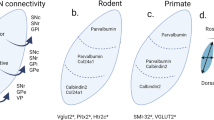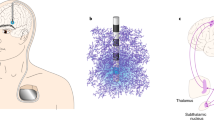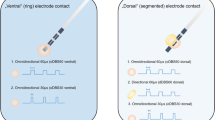Abstract
Deep brain stimulation (DBS) is a widely used neurosurgical approach to treating tremor and other movement disorders1,2,3. In addition, the use of DBS in a number of psychiatric diseases, including obsessive-compulsive disorders and depression, is currently being tested4,5,6. Despite the rapid increase in the number of individuals with surgically implanted stimulation electrodes, the cellular pathways involved in mediating the effects of DBS remain unknown1. Here we show that DBS is associated with a marked increase in the release of ATP, resulting in accumulation of its catabolic product, adenosine. Adenosine A1 receptor activation depresses excitatory transmission in the thalamus and reduces both tremor- and DBS-induced side effects. Intrathalamic infusion of A1 receptor agonists directly reduces tremor, whereas adenosine A1 receptor–null mice show involuntary movements and seizure at stimulation intensities below the therapeutic level. Furthermore, our data indicate that endogenous adenosine mechanisms are active in tremor, thus supporting the clinical notion that caffeine, a nonselective adenosine receptor antagonist, can trigger or exacerbate essential tremor7. Our findings suggest that nonsynaptic mechanisms involving the activation of A1 receptors suppress tremor activity and limit stimulation-induced side effects, thereby providing a new pharmacological target to replace or improve the efficacy of DBS.
This is a preview of subscription content, access via your institution
Access options
Subscribe to this journal
Receive 12 print issues and online access
$209.00 per year
only $17.42 per issue
Buy this article
- Purchase on Springer Link
- Instant access to full article PDF
Prices may be subject to local taxes which are calculated during checkout




Similar content being viewed by others
References
Lozano, A.M. & Eltahawy, H. How does DBS work? Suppl. Clin. Neurophysiol. 57, 733–736 (2004).
Marks, W.J. Deep brain stimulation for dystonia. Curr. Treat. Options Neurol. 7, 237–243 (2005).
Hamani, C. et al. Deep brain stimulation for chronic neuropathic pain: long-term outcome and the incidence of insertional effect. Pain 125, 188–196 (2006).
McIntyre, C.C., Savasta, M., Walter, B.L. & Vitek, J.L. How does deep brain stimulation work? Present understanding and future questions. J. Clin. Neurophysiol. 21, 40–50 (2004).
Mayberg, H.S. et al. Deep brain stimulation for treatment-resistant depression. Neuron 45, 651–660 (2005).
Wichmann, T. & Delong, M.R. Deep brain stimulation for neurologic and neuropsychiatric disorders. Neuron 52, 197–204 (2006).
Louis, E.D. et al. Semiquantitative study of current coffee, caffeine and ethanol intake in essential tremor cases and controls. Mov. Disord. 19, 499–504 (2004).
Wang, X. et al. P2X7 receptor inhibition improves recovery after spinal cord injury. Nat. Med. 10, 821–827 (2004).
Arcuino, G. et al. Intercellular calcium signaling mediated by point-source burst release of ATP. Proc. Natl. Acad. Sci. USA 99, 9840–9845 (2002).
Benabid, A.L. et al. Chronic electrical stimulation of the ventralis intermedius nucleus of the thalamus as a treatment of movement disorders. J. Neurosurg. 84, 203–214 (1996).
McIntyre, C.C. & Grill, W.M. Extracellular stimulation of central neurons: influence of stimulus waveform and frequency on neuronal output. J. Neurophysiol. 88, 1592–1604 (2002).
Cotrina, M.L. et al. Connexins regulate calcium signaling by controlling ATP release. Proc. Natl. Acad. Sci. USA 95, 15735–15740 (1998).
Burnstock, G. Physiology and pathophysiology of purinergic neurotransmission. Physiol. Rev. 87, 659–797 (2007).
Wang, X. et al. Astrocytic Ca2+ signaling evoked by sensory stimulation in vivo. Nat. Neurosci. 9, 816–823 (2006).
Dunwiddie, T.V., Diao, L. & Proctor, W.R. Adenine nucleotides undergo rapid, quantitative conversion to adenosine in the extracellular space in rat hippocampus. J. Neurosci. 17, 7673–7682 (1997).
Wall, M.J. & Dale, N. Auto-inhibition of parallel fibre–Purkinje cell synapses by activity dependent adenosine release. J. Physiol. (Lond.) 581, 553–565 (2007).
Anderson, T.R., Hu, B., Iremonger, K. & Kiss, Z.H. Selective attenuation of afferent synaptic transmission as a mechanism of thalamic deep brain stimulation–induced tremor arrest. J. Neurosci. 26, 841–850 (2006).
Gomes, P., Srinivas, S.P., Van Driessche, W., Vereecke, J. & Himpens, B. ATP release through connexin hemichannels in corneal endothelial cells. Invest. Ophthalmol. Vis. Sci. 46, 1208–1218 (2005).
Sun, D. et al. Mediation of tubuloglomerular feedback by adenosine: evidence from mice lacking adenosine 1 receptors. Proc. Natl. Acad. Sci. USA 98, 9983–9988 (2001).
Cousins, M.S., Carriero, D.L. & Salamone, J.D. Tremulous jaw movements induced by the acetylcholinesterase inhibitor tacrine: effects of antiparkinsonian drugs. Eur. J. Pharmacol. 322, 137–145 (1997).
Jolicoeur, F.B., Rivest, R. & Drumheller, A. Hypokinesia, rigidity, and tremor induced by hypothalamic 6-OHDA lesions in the rat. Brain Res. Bull. 26, 317–320 (1991).
Martin, F.C., Thu Le, A. & Handforth, A. Harmaline-induced tremor as a potential preclinical screening method for essential tremor medications. Mov. Disord. 20, 298–305 (2005).
Wilms, H., Sievers, J. & Deuschl, G. Animal models of tremor. Mov. Disord. 14, 557–571 (1999).
Milner, T.E., Cadoret, G., Lessard, L. & Smith, A.M. EMG analysis of harmaline-induced tremor in normal and three strains of mutant mice with Purkinje cell degeneration and the role of the inferior olive. J. Neurophysiol. 73, 2568–2577 (1995).
Boulet, S. et al. Subthalamic stimulation–induced forelimb dyskinesias are linked to an increase in glutamate levels in the substantia nigra pars reticulata. J. Neurosci. 26, 10768–10776 (2006).
Perlmutter, J.S. & Mink, J.W. Deep brain stimulation. Annu. Rev. Neurosci. 29, 229–257 (2006).
Zhang, J.M. et al. ATP released by astrocytes mediates glutamatergic activity–dependent heterosynaptic suppression. Neuron 40, 971–982 (2003).
Pascual, O. et al. Astrocytic purinergic signaling coordinates synaptic networks. Science 310, 113–116 (2005).
Jiang, L., Xu, J., Nedergaard, M. & Kang, J. A kainate receptor increases the efficacy of GABAergic synapses. Neuron 30, 503–513 (2001).
Kuncel, A.M. & Grill, W.M. Selection of stimulus parameters for deep brain stimulation. Clin. Neurophysiol. 115, 2431–2441 (2004).
Acknowledgements
We thank S. Goldman and E. Vates for comments on the manuscript. This work was supported by the Mathers Charitable Foundation; National Institutes of Health grants NS30007, NS39559 and NS050315; the Adelson Program in Neural Repair and Regeneration; The Philip-Morris Organization; the New York State Spinal Cord Injury Research Board and the Canadian Institutes of Health Research.
Author information
Authors and Affiliations
Corresponding authors
Supplementary information
Supplementary Text and Figures
Supplementary Figs. 1–5 (PDF 2083 kb)
Rights and permissions
About this article
Cite this article
Bekar, L., Libionka, W., Tian, GF. et al. Adenosine is crucial for deep brain stimulation–mediated attenuation of tremor. Nat Med 14, 75–80 (2008). https://doi.org/10.1038/nm1693
Received:
Accepted:
Published:
Issue Date:
DOI: https://doi.org/10.1038/nm1693
This article is cited by
-
CENEPSIA: feasibility of an ultrasound device to treat epileptic refractory foci
Research on Biomedical Engineering (2023)
-
The effects of electrical stimulation on glial cell behaviour
BMC Biomedical Engineering (2022)
-
Deep brain stimulation creates informational lesion through membrane depolarization in mouse hippocampus
Nature Communications (2022)
-
Hypothermia evoked by stimulation of medial preoptic nucleus protects the brain in a mouse model of ischaemia
Nature Communications (2022)
-
Input-selective adenosine A1 receptor-mediated synaptic depression of excitatory transmission in dorsal striatum
Scientific Reports (2021)



